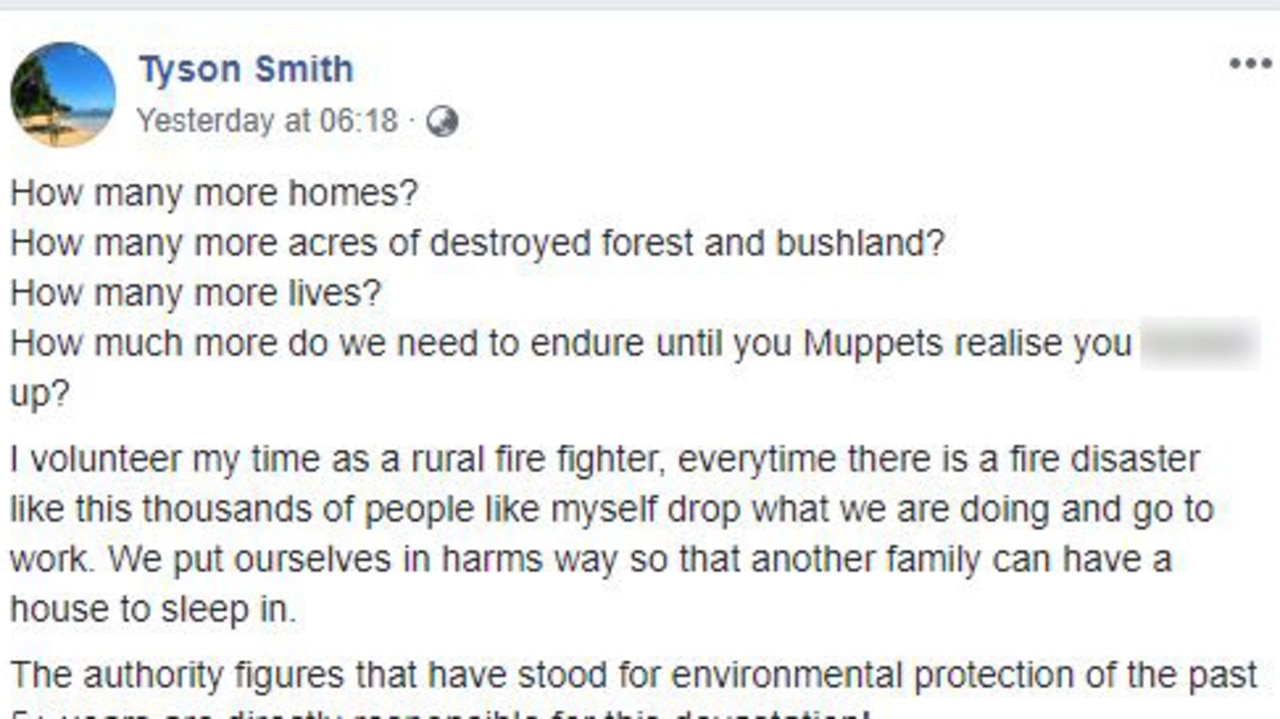Rural firefighter’s heartbreaking plea
A rural firefighter has issued a heartbreaking plea on social media, taking on environmental policies and saying “enough is enough”.
As catastrophic fires burn across Queensland and New South Wales — with experts warning that the worst is yet to come on Tuesday — rural firefighter Tyson Smith has issued a heartbreaking plea on Facebook.
The post, which has been shared more than 2600 times and liked by over 1600 people, asks how much more it will take before the government acknowledges current fires are the result of a larger issue.
Three people have died in NSW, and 200 homes and sheds lost to bushfires in both states over the weekend.
RELATED: ‘Catastrophic’ fire danger as Australia burns

“How many more homes?” wrote Smith. “How many more acres of destroyed forest and bushland? How many more lives? How much more do we need to endure until you Muppets realise you f**ked up?”
Smith, who volunteers his time as a rural firefighter in Queensland, said that every time there is a disaster like this, “thousands of people like myself drop what we are doing and go to work. We put ourselves in harm’s way so that another family can have a house to sleep in.”
The “authority figures that have stood for environmental protection” over the past five years are “directly responsible for this devastation”, Smith wrote.
“The fuel loading we are seeing out on the ground is ridiculous. We are looking at 5-10 years of growth, this fuel source is making these fires untouchable, we can’t even get near them to fight them.”
RELATED: 64 schools in NSW close due to bushfire risk
The heat generated from the fires burning in NSW and QLD “kills everything, right down to the microbes deep in the soil. It takes years for these areas to regenerate!” Smith wrote.
“The controlled reduction burns we do only skim the surface, they safely remove the fuel without destroying the place.”
Smith said the environmental authorities who have a put a stop to reduction burns — which include controlled burning, mechanical clearing like slashing undergrowth, or even reducing the ground fuel by hand — “need to be held personally accountable for the losses people have endured. People have lost their lives as a direct result of the decisions made by the environmental authorities!”
The firey ended the post, asking, “Tell me why these enviros shouldn’t be stood up in front of a judge and charged with manslaughter? Enough is enough!”
A Department of Environment and Science (DES) spokesperson said the agency works to reduce fuel loads and minimise the impact from fires by carrying out planned burns.
“The department takes its obligations in regards to fire management very seriously, with priority given to protecting life and property, particularly where urban and rural communities adjoin our parks and forests,” the spokeswoman said.
“This year, since January, there have been 296 planned burns conducted in protected areas, covering more than one million hectares. This most hectares treated by planned burns in five years.”
In an article on The Conversation, Professor David Bowman of the University of Tasmania explains that fire reduction burning is different from “back burning”.
The purpose of fire reduction burning is to reduce the intensity of fires by removing things such as leaf litter.
Research has found that doubling the fuel in a forest will double the rate of spread and quadruple the fire intensity.
However, Prof Bowman noted that reduction burning can only be used on open flammable vegetation, and was too risky in dense eucalypt forests.
It also has to be done frequently to be effective and this has raised concerns among ecologists.
“In Victoria, for instance, the 5 per cent fuel-reduction target means a given area of bush will be burnt every 20 years,” he wrote.
“But ecologists are concerned that such high frequencies can have damaging effects on plant and animal species that require longer fire-free intervals to complete their life cycles.”
Prof Bowman said there was debate about the effectiveness of fuel-reduction burning, given that a huge area of landscape needs to be treated.
“It must be acknowledged that such targeted burning is expensive to carry out safely given the need for engagement with numerous stakeholders (private land owners, councils, various branches of government).
“It is also dangerous work, which carries a risk of destroying houses and infrastructure if the fires escape control.”
Another serious side effect was smoke pollution.
“Because of these constraints, attention is increasingly being focused on managing fuel without burning,” he wrote.
“This can involve using herbivores and thinning vegetation, including burning the debris in specially designed portable furnaces that have low smoke emissions.”
He said there was growing evidence that areas close to the bushland suburbs (also known as the wildland-urban interface) benefited the most.



